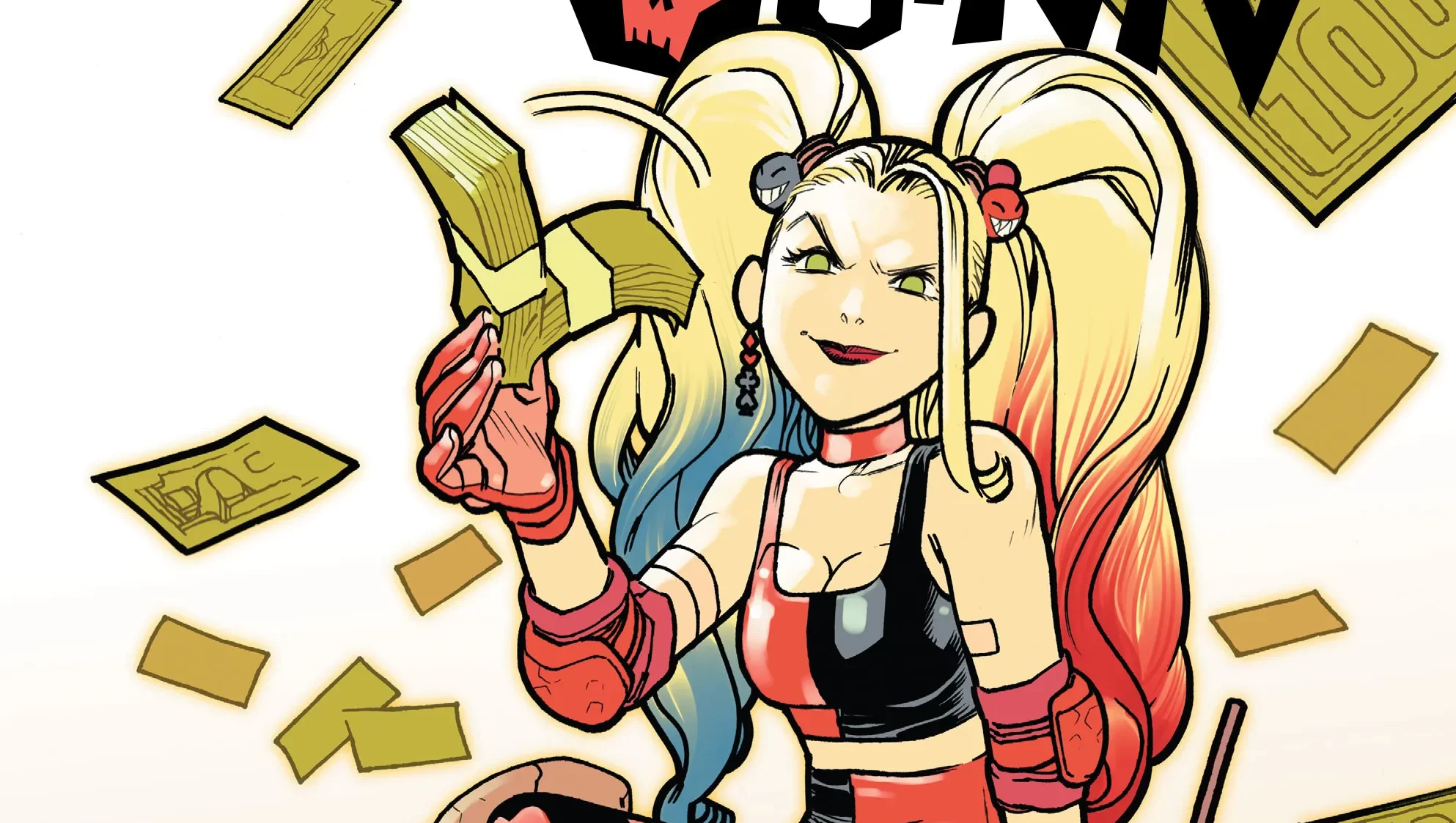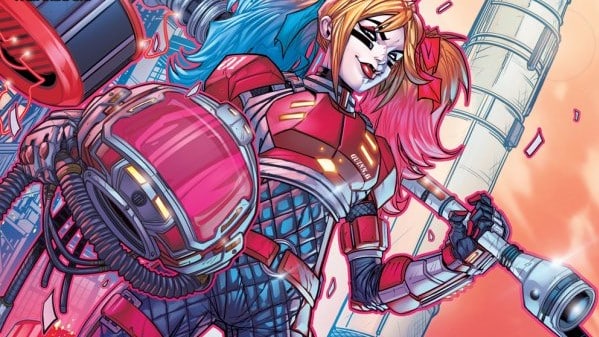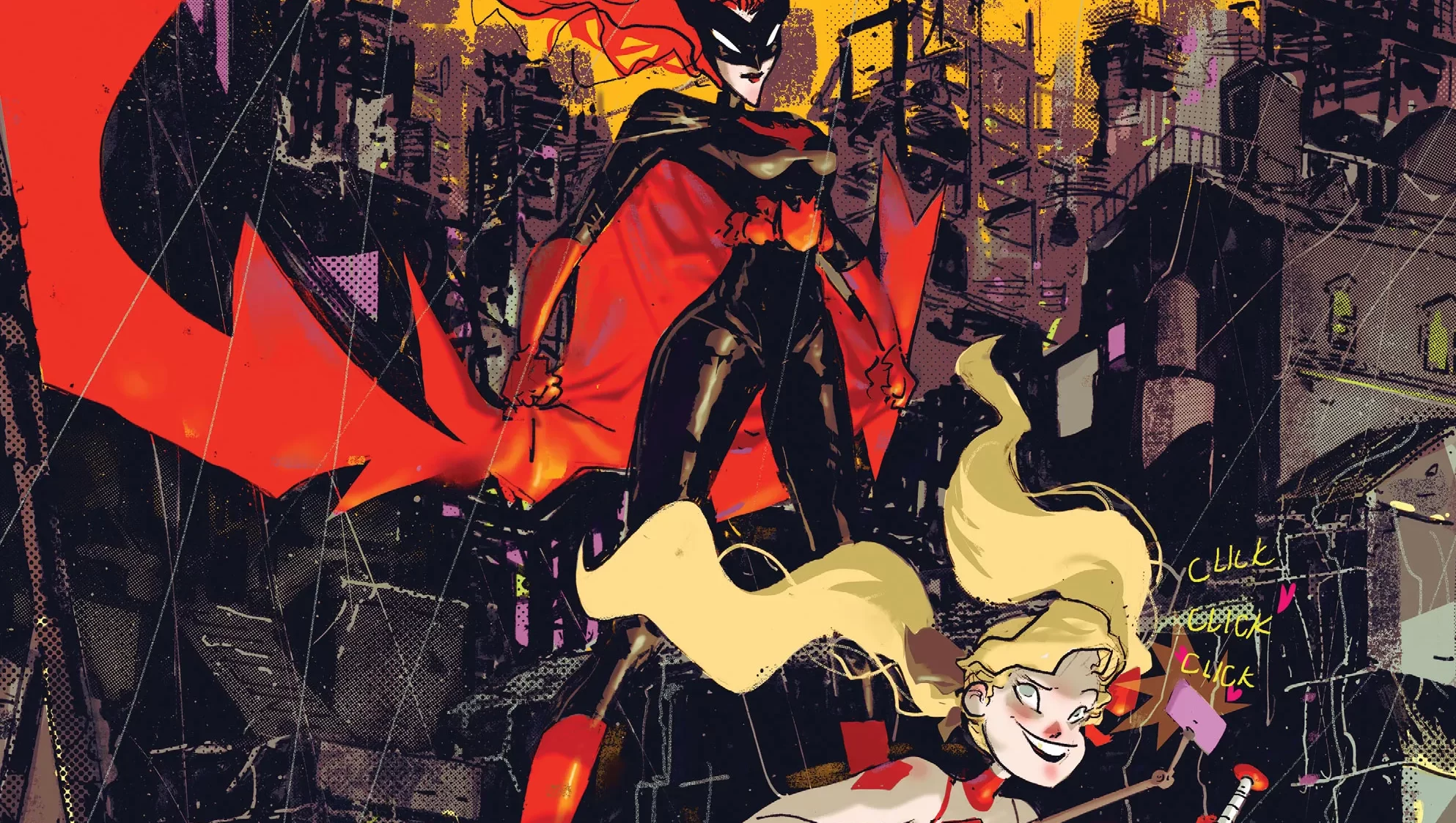Welcome, readers, to an all-new column, covering all things related to Gotham’s various citizens, no matter how far they may be from home. The esteemed Bat Chat may cover all things Batman…but for everything else, It’s Not So Bat Chat, here at ComicsXF!
For our debut week, we’re celebrating long time antagonist and short time ally, the ever-irreverent Harley Quinn – and her partner, Poison Ivy! First up is the Harley and the Suicide Squad XX take down the monster Luke Fox created in Harley Quinn Annual (2022), written by Stephanie Phillips, drawn by Simone Buonfantino and Georges Duarte, colored by Romulo Fajardo Jr., and lettered by AndWold design, with a back-up story written by Stephanie Phillips, drawn by David Baldeon, colored by Antonio Fabella and lettered by AndWorld Design.
Next, tying in to Season 3 of the Harley Quinn: The Animated Series is the title that tells you all you need to know with The Real Sidekicks of New Gotham Special #1, an anthology featuring:
Tawky Tawks, written by Tee Franklin, drawn by Max Sarin, and colored by Marissa Louise.
Double Date, written by Tee Franklin, drawn by ONeill Jones, and colored by Jordie Bellaire.
Identity Crisis, written by Alexis Quasarano, and drawn by Erica Henderson.
Showtime!, written by Conner Shin and drawn by Logan Faerber.
Wild Ride, written by Jimmy Mosqueda, drawn by PJ Holden and colored by Dee Cunniffe.
Two Jokers, written by Jamiesen Borak, drawn by Jon Mikel, and colored by Nik Filardi.
All stories lettered by Taylor Esposito.
Lastly, Poison Ivy furthers her plans for the global extinction of the human race by…getting a day job at a packaging plant. If she didn’t already hate humans before, this place isn’t going to help, in Poison Ivy #3, written by G. Willow Wilson, drawn by Marcio Takara, colored by Arif Prianto and lettered by Hassan Otsmane-Elhaou.
Goop Monsters Galore

We begin with an ending – Harley Quinn wraps up the Suicide Squad XX arc as the team defeats an experiment with Element X gone wrong. If you’ve been following along, you’ll know that the writing of this has been uneven. The members of the Suicide Squad XX were all thrown in rather suddenly, and we get very little time to warm to them. The exceptions of Verdict, who brings in almost nothing from the arc she was previously in, and Harley, who for a large part of this arc had been sidelined into being comic relief to give some spotlight to Luke Fox, who seems to have been slowly taking over the series as protagonist.
The Annual, however, throws a lot to the side — including the narrative captions, which I found myself missing — and simply goes all in on superheroic shenanigans. The team’s finally in full costume, using their upgraded weapons, slamming down minions left and right before heading in for the final fight with the big boss.
Many Annuals take a step away from the continuity of the main line, inviting readers a sample taste of the title, hoping to draw them into the series proper. If you want to come into this Annual blind, you’re not missing all that much. Suicide Squad XX had a lot of potential, some of it teased, some of it partially resolved — there were glimpses of moments that would have been interesting to explore, but the conclusion drops all pretense of being much more than your basic mishmash of characters, your familiar superhero romp.
It is a fun romp, don’t get me wrong. Very few distractions from the action, even, which tends to be the case with these series. The art is cute, and lively, the colors glow, shifting admirably between threatening shades and highlighting the cool. I’m not going to say I didn’t like the team…but had you switched everyone out but Harley Quinn, I’m not sure if the story would have changed much at all.
The back-up story brings us back to the slightly more familiar. It’s a fun, fairly straightforward prologue to the next story to come. Harley’s spending the money she got from her recent work with Luke Fox, living it up in Vegas…and bringing her best friend, Kevin with her. It’s a chance for us to catch up with Kevin, who’s been absent for this last arc, and I’ve missed him. He has a wonderful relationship with Harley Quinn — they are there for each other, they can riff at each other’s shortcomings, and they support each other when the future looks uncertain. Harley’s between arcs, at the moment, so the future’s definitely in question…though, of course, the bigger question is, what is the strange blue goop alien that’s been hiding in her luggage?
I enjoyed reading these, but they miss out on the heart of a good Harley comic. There’s a lot of great work, and heartening growth that’s been put into this series that is barely reflected in the annual at all. I had fun here — but if I had to judge the series based solely off of these two stories and not the ones that came before — or my existing love of the character — Harley Quinn might not be a series I’d be picking up again.
Six Sidekick Stories

Taking advantage of the currently-airing Season 3 of the show is an anthology series of the unique world of Harley Quinn: The Animated Series — as well as the expanded world we saw in the Eat, Bang, Kill! Tour series bridging Seasons 2 & 3. The writer from that latter series, Tee Franklin, comes back with her series’ collaborator, Max Sarin, to weave the A-story through this anthology, as talk show host Tawny Young gathers the cast’s stories on her talk show.
I’ll be honest, this anthology is a bit of a mess. Despite bringing in writers familiar with this world — Tee Franklin having written the excellent mini-series, and the other writers all having contributed to the show itself — and a line-up of great artists, this book feels crammed with characters who fall flat, and humor that falls flatter. There are a few rare moments that shine within these stories, and even those are barely worth more than a chuckle or two.
The Tawky Tawks sections are definitely the highlight of the book. Franklin has not just a great handle on this particular world’s characters, but the DC Universe as a whole, bringing a fun bunch of little Easter Eggs and nods into the story — and following up each writer’s tale with a talk show response of her own. The art is a delight, Max Sarin always dials the emotions up to an eleven, bringing a lot of joy, detail, and life to relatively quick pages — the book was worth a reread for that art alone.
As for the stories themselves, though — like I said, a lot of them fell flat. Some of them have sudden, inconclusive endings, possibly leaving room for a Tawky Tawks wrap-up, a transition that is rarely smooth. While “Double Date” was a fun read for anyone who enjoyed Vixen and her new girlfriend, Elle, from the Eat, Bang, Kill! Tour, there wasn’t a lot of heft to the story itself – and with last minute mystery White Rabbit appearance whose inclusion went nowhere, you leave the story feeling unsatisfied.
“Identity Crisis” began promisingly. With Erica Henderson on art, you have the amusement of realizing how much overlap there is between Henderson’s Unbeatable Squirrel Girl and the animated series’ take on Batgirl. The story soon runs into some very confusing storytelling as Batgirl attempts to stop a hacker — the art dives into a world of ciphers, puzzles, and superhero action all standing in as metaphors for hacking, but it ends up being a lot more confusing than anything else. It’s a problem we see come up again in “Wild Ride.”
While the Clayface of “Show Time” seems a little off from the Shakespeare-quoting, scenery chewing extravagance brought in by Alan Tudyk’s performance on the show, “Show Time” was still an overall charming tale of a down-on-his-luck shapeshifting actor and the daughter who came out of it. I was taken by the art — cartoonish, expressive, and dynamic. Every panel feels alive, and in motion, and the story was something I hope to see again.
“Two Jokers” was the funniest of the bunch by far. It’s a simple gag, as Joker meets his old college buddy (a light shot at the Three Jokers story), and the two quibble and then bond over how much they’ve changed over the years. It’s a simple story that works perfectly for an anthology — built around a simple idea, it gets in and out before wearing out its welcome.
I can’t believe that the “Two Jokers” story comes up as being one of my favorites, but truly, the rest of the book could have benefitted from following its lead. Anyone picking up this book comes in for a sample platter of humor — and unfortunately, what we got instead is a messy plate of ideas that don’t all quite work, but a few flavors that stood out, nonetheless.
Murdering Monsters of the Mundane

For the past two issues of Poison Ivy, it’s felt like we’ve been shown reasons why Ivy might be convinced NOT to wipe out humanity with toxic spores. In this issue, however, if Ivy was being tempted off that path, her new boss has thrown her right back on it.
We waste no time getting to know Ivy’s new boss, George Halloran, and he’s loathsome in all the ways horrible bosses can be — though Ivy is being reminded of a more particular loathsome boss from her past. I assumed this to mean Jason Woodrue, the Floronic Man, but between mentions of someone known as the Green Man (we’ll get to that later) and the number of different origins Ivy’s had in recent years, it’s hard to say for sure.
For now, though, it doesn’t matter. Ivy’s not here for vengeance — she’s here to spread her spores through by lacing packages with them, to be delivered around the world. It’s a relatively efficient plan, considering Ivy’s working alone. The packages won’t reach everybody, but then again, we don’t know how widely they spread once activated.
Ivy’s got one job. But Halloran’s disgusting and oppressive ways become increasingly hard to ignore — and Ivy is a vengeful woman.
There is no one quite as petty as a middle manager. Someone who’s the boss of a very small empire. Who clings to power so desperately he feels like he’s going to lose it if he doesn’t abuse it. The smugness of a man who has power he knows he doesn’t deserve, who holds desperately onto any lie that lets him keep feeling that way.
And as we saw back in #2, Ivy’s been a goddess.
There is a rather horrifying parallel that is quietly drawn between Halloran and Ivy — one that the Floronic Man often embodies. Woodrue is the petty, spiteful, plant-controlling monster that Ivy can pride herself on not being. In her worst moments though…when she starts to hate the people surrounding her, when she starts using fear as a tool to get something she wants — is she coming close?
The answer is no, of course, but that the book brings up the question, and puts the Green Man firmly in the same category as Halloran, is interesting. This is a series that has done a lovely job of defining different aspects of Ivy. What drives her, what haunts her, what brings her joy, who she is, and here…who she is not. She may be monstrous, slipping the role on like one would put on a coat — but she’s not quite a monster.
As Ivy’s hallucinogens get worse, the art and lettering team get a lot more to play with. The pages burn as Ivy’s wrath takes charge, the letters washed in Delirium-like dreaminess. Things are getting darker in this book, as it moves on towards its end. The threat that’s been teased feels like it’s right on the horizon. The end is drawing near, and I am very, very excited to see how all this turns out.






